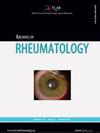风湿病儿童的 COVID-19 疫苗接种率和影响接种的因素
IF 1.1
4区 医学
Q4 Medicine
引用次数: 0
摘要
研究目的本研究旨在调查风湿病患儿的冠状病毒病 2019(COVID-19)疫苗接种率以及影响疫苗接种的因素。患者和方法:这项多中心横断面调查研究于 2022 年 7 月至 2022 年 9 月期间进行。患者组包括 474 名患者(女性 256 名,男性 218 名;中位年龄:15 岁;四分位数间距:13 至 16 岁),对照组包括 211 名健康儿童(女性 124 名,男性 87 名;中位年龄:15 岁;四分位数间距:13 至 16 岁)。在常规门诊就诊时,对家长进行了面对面的问卷调查。结果:在这些患者中,220 人被诊断为自身炎症性疾病,174 人被诊断为幼年特发性关节炎,48 人被诊断为结缔组织病,23 人被诊断为血管炎,8 人被诊断为葡萄膜炎,1 人被诊断为肉样瘤病。在研究组中,256 名(54%)患者和 115 名(54.5%)健康儿童至少接种了一剂 COVID-19 疫苗。父母对疫苗潜在副作用的担忧是两组儿童犹豫接种 COVID-19 疫苗的最常见原因。接种过疫苗的患者的中位年龄、随访时间、秋水仙碱治疗率、儿童疫苗接种率和流感疫苗接种率、父母中位年龄、父母疫苗接种率和父母受教育程度均较高(P<0.05)。此外,与风湿病团队交流过疫苗接种顾虑的患者的疫苗接种率也较高(P<0.001)。结论研究发现,家长对安全性和副作用的担忧是影响疫苗接种成功率的最重要因素。找出家长对疫苗犹豫不决的根本原因将有助于制定有效的疫苗接种策略,应对未来可能爆发的疫情。本文章由计算机程序翻译,如有差异,请以英文原文为准。
COVID-19 vaccination rates and factors affecting vaccination in children with rheumatic disease
Objectives: This study aimed to investigate coronavirus disease 2019 (COVID-19) vaccination rates and factors affecting vaccination in children with rheumatic diseases.
Patients and methods: This multicenter cross-sectional survey-based study was conducted between July 2022 and September 2022. Four hundred seventy-four patients (256 females, 218 males; median age: 15 years; interquartile range, 13 to 16 years) were included in the patient group, and 211 healthy children (124 females, 87 males; median age: 15 years; interquartile range, 13 to 16 years) were included in the control group. A questionnaire was administered to the parents face-to-face during routine outpatient visits.
Results: Of the patients, 220 were followed up with the diagnosis of autoinflammatory disease, 174 with juvenile idiopathic arthritis, 48 with connective tissue disease, 23 with vasculitis, eight with uveitis, and one with sarcoidosis. In the study group, 256 (54%) patients and 115 (54.5%) healthy children received at least one dose of COVID-19 vaccine. Parents' concern regarding potential side effects of the vaccine was the most common reason for COVID-19 vaccination hesitancy in both groups. The median patient age, follow-up period, colchicine treatment rates, childhood vaccination and influenza vaccination rates, median parental age, parental vaccination rate, and parental education level were higher in vaccinated patients (p<0.05 for all). In addition, vaccination rates were high in patients who shared their concerns about vaccination with the rheumatology team (p<0.001).
Conclusion: Parents' concerns about safety and side effects were found to be the most important factors affecting vaccination success. Identification of the underlying causes of parental vaccine hesitancy will facilitate the development of effective vaccination strategies for potential future outbreaks.
求助全文
通过发布文献求助,成功后即可免费获取论文全文。
去求助
来源期刊

Archives of rheumatology
Medicine-Rheumatology
CiteScore
2.00
自引率
9.10%
发文量
15
期刊介绍:
The Archives of Rheumatology is an official journal of the Turkish League Against Rheumatism (TLAR) and is published quarterly in March, June, September, and December. It publishes original work on all aspects of rheumatology and disorders of the musculoskeletal system. The priority of the Archives of Rheumatology is to publish high-quality original research articles, especially in inflammatory rheumatic disorders. In addition to research articles, brief reports, reviews, editorials, letters to the editor can also be published. It is an independent peer-reviewed international journal printed in English. Manuscripts are refereed by a "double-blind peer-reviewed" process for both referees and authors.
Editorial Board of the Archives of Rheumatology works under the principles of The World Association of Medical Editors (WAME), the International Council of Medical Journal Editors (ICMJE), and Committee on Publication Ethics (COPE).
 求助内容:
求助内容: 应助结果提醒方式:
应助结果提醒方式:


